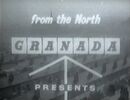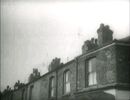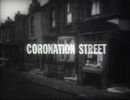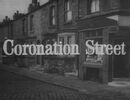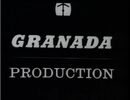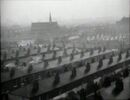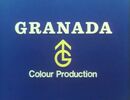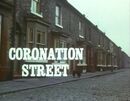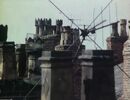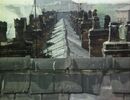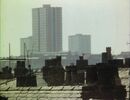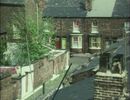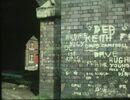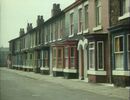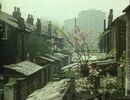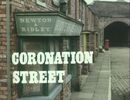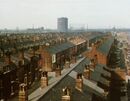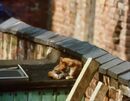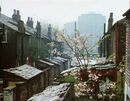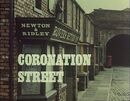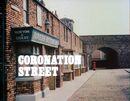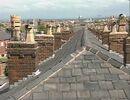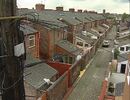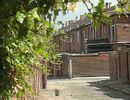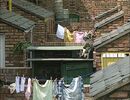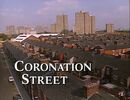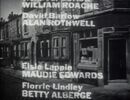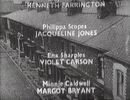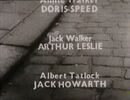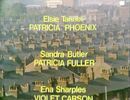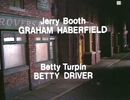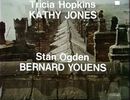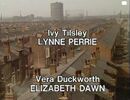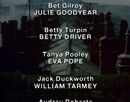
Coronation Street's current title sequence, an update to the eighth sequence which was introduced in 2010
A title sequence is a segment of a television programme designed as an introduction to each episode. It typically takes the form of a short graphical sequence played against the show's theme music, presenting the programme's title, and often the names of key members of the production and cast.
In all there have been eight main title sequences in Coronation Street's history, with new versions debuting in 1960, 1964, 1969, 1975, 1976, 1990, 2002 and 2010. In most cases, the change has coincided with a change in production method (eg. colour, HD). Each one follows roughly the same formula of various shots of terraced streets representing the programme's setting of Weatherfield. Details of each sequence, their variations, and associated ad bumpers and end credits, are given below.
Title sequences
1960 sequence
Coronation Street 's first set of black and white titles consists of an opening clip of the rooftops of Weatherfield, over which the Granada Television logo is superimposed. This was taken from a mill building in Ordsall Road in Salford with St. Clement's Church in the distance. The view then changes to a panning shot of the Corner Shop end of Coronation Street, filmed in Archie Street, Salford, which Tony Warren and Denis Parkin chose as the design inspiration for Florizel Street when the programme was in pre-production in 1960. The sequence is unique in that the programme's logo appears over the Corner Shop end of the street instead of the Rovers Return Inn side; this was to hide the differences between the real and fictional streets (see the article on Archie Street for more information).
Occasionally in the 1960s when the first scene of an episode was set in the Street, the sequence would be cut short and the logo and music would play over the start of the scene instead. Many times in the decade some or all of the title sequence would be dispensed with if the Street set had been erected in the studio for the episodes in question (no outdoor set being built until 1968), Episode 95 on 8th November 1961 and Episode 108 on 25th December of the same year being examples.
There was a variant in this sequence in the form of the typeface in the logo from Episode 13 on 20th January 1961 onwards to a larger, more condensed version of Times New Roman. Otherwise the sequence remained the same.
This sequence was used until Episode 336 on 2nd March 1964 after which there was a three month period where there was no sequence run and the programme title was shown exclusively over the opening scene, location or a photocaption of the terraced rooftops of Ordsall (see individual episode pages for a full list of these variants).
1964 sequence
The second title sequence was introduced shortly after the entrance to the Corner Shop was moved from the corner of Coronation Street, rendering the original titles inaccurate. New producer Tim Aspinall brought in the change in the sequence which was introduced with Episode 366 on 15th June 1964. In the new version, the shot of Archie Street from the front is replaced by a view of a ginnel with a woman scrubbing the path in the background. This latter shot was filmed between Archie Street and Clement Street and the outline of the eastern end of St. Clement's Church can clearly be seen at the end of the ginnel as a car drives along Cavendish Street.
On occasion in the middle of the decade the title caption would be displayed over the opening scene of the episode, irrespective of where it took place and no title sequence would be run at all.
1969 sequence
In 1969, the proogramme transitioned to colour and this necessitated a new title sequence which made its debut with Episode 930 on 24th November. The sequence begins with an establishing shot of a tower block, before panning over to rows of terraced houses and finally cutting to a ground-level shot of a generic terraced street.
The location of the opening shot was Grafton Court tower block on Clayton Close in Hulme, Manchester with the camera situated on the next door Clifford Court. The empty land in the distance to the right of Grafton Court as the sequence opens is in Hulme and Moss Side, whose streets had just been demolished in 1969. The industrial buildings immediately to the left of Grafton Court are on Cornbrook Street, Old Trafford (some of which are still there today) and the vast number of houses further left as the shot pans along are in the since-demolished area between Cornbrook Street, Shrewsbury Street and Stretford Road although the terraced streets further on beyond Shrewsbury Street and in the foggy distance are still extant.
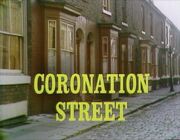
The title caption used for the first two advertised colour episodes
Coronation Street had an outdoor set when this sequence was shot and in anticipation of the switch to colour the set was rebuilt in brick, which would look better on the new cameras than the wooden studio frontage which had been used in outdoor scenes since 1968. At the time of recording the new sequence, the set had not finished construction, and so Coronation Street doesn't appear in it. Additionally, the programme was first broadcast in colour for one week prior to the new sequence being utilised and as it does not seem to have been ready Episodes 928 and 929 broadcast on 17th and 19th November used a colour photocaption of a terraced street (usually used for the "Part Two" photocaption in the early colour years) at the start of the episode with the programme title superimposed on it.
The programme's graphics were yellow in colour but these were amended in early 1970 to white.
1975 sequence
The next time Coronation Street changed its opening credits sequence, with Episode 1500 on 11th June 1975, it included for the first time a shot of the actual outdoor set built next to the Quay Street studios, along with a series of close ups of chimneys of various terraced houses.
Compared to previous sequences, this was a relatively fast-moving montage with eleven different shots. Letters written to the Manchester Evening News in 1982 identified several of the streets shown as being Duke Street and Ascension Street in the Lower Broughton area of Salford and the block of flats in the penultimate shot as being between Sussex Street and Harrison Street in the same district (the towers being named as Frank Cowan Court and Benjamin Wilson Court and since demolished). The sixth shot depicts the Bradford and Beswick area of Manchester looking towards the north west and showing the Bradford Road gasworks in the distance. It was filmed from a vantage point near Ashton Old Road, probably taken from the high-rise "Fort Beswick" flats which stood in the area at the time. The main street running down the shot is Carmen Street intersected by Myrtle Street in the foreground and Morley Street further back. To the right of the picture a bus can be glimpsed travelling down Albert Street. The gasometer to the left has since been demolished, as have almost all of the buildings seen on screen and in their place the City of Manchester stadium, home to the 2002 Commonwealth Games and now called the Etihad Stadium, has been built in the middle distance between the camera vantage point and the remaining gasometer.
The 1975 sequence was the shortest-lived in the programme's history but many of its shots were kept for its 1976 replacement.
1976 sequence
Incoming producer Bill Podmore was annoyed by the large number of shots within the limited time-frame when he took over the programme in 1976 as he related in his 1990 memoir Coronation Street - The Inside Story:
- "The quick-changing views over the slated rooftops of Salford...seemed to be out of time with the slow, haunting refrains of Eric Spear's signature tune.
- "I asked to see all the sequence film, shot years before in the back streets of Old Trafford and Lower Broughton. Although much of it lay on the cutting room floor, it was reassembled into a continuous film. Suddenly, on walked that wonderful cat. When it curled up in the spring sunshine I knew I had found the perfect clip. It looked exactly as though it had contentedly sat down to watch the programme, and from that the day the Coronation Street cat became almost as famous as any character on the show. It provided us with an enduring mystery, too. Any number of people, imposters all, insisted they were the owners, but its true identity was never discovered." (see section below for more on the cat).
Under Podmore's direction the sequence was revamped to slow its pace down by removing most of the chimney shots and bringing forward the sixth shot, a distance shot over rows of terraced rooftops, to the forefront of the sequence.
The new titles made their debut with Episode 1596 on 3rd May 1976 and ran until Episode 3133 on 12th October 1990, making them the longest-used titles in the programme's history. The sequence remained the same throughout this period with the exception of the final shot, which was replaced with Episode 1768 on 26th December 1977 following the refurbishment of the Rovers Return exterior, and again (more noticeably) to display the construction of a new outdoor set in Episode 2210 on 7th June 1982. The sequence was the last to open with a fade from the Granada Television logo, as this practice was dropped in 1988.
1990 sequence
In 1988, Coronation Street abandoned the use of film for location sequences in favour of videotape, giving the programme a uniform look across all of its scenes. The only exception was the title sequence, which remained in place for a further two years. A new videotaped set of titles eventually debuted with Episode 3134 on 15th October 1990. The sequence followed the same formula as its predecessor, and established the cat as an ongoing tradition. The pace is slightly faster than the 1976 sequence, with a heavy use of crane shots.
The opening shot showed Alpha Street in the Langworthy district of Salford, looking south-east towards the blocks of flats on Rosehill Close with the jagged roofs of the factory building on Highfield Road between the two. Other shots in the sequence included Laburnum Street in the same district and streets in Bolton.
In the early 1990s, the sequence regularly ended with a shot from the Rovers end of the Street with a dog frantically running up past an elderly woman, although as the decade went on this shot was often left out and it appeared for the last time in Episode 3819 on 17th February 1995. Instead a differing number of shots of activity in the Street closed the sequence and if the opening scene was set outside, then the title caption appeared over the start of that scene. New producer Brian Park moved to regularise the sequence again and from Episode 4168 on 30th March 1997 onwards the logo was superimposed over the shot of a cat relaxing in a back yard, which had previously been the penultimate shot.
From Episode 4704 on 24th October 1999, the title sequence began including writer and director credits, and the Coronation Street logo was revamped and moved to the start of the sequence rather than the end.
Although timeline-wise, this sequence did not run as long as the 1976 version, its various incarnations were used on some 2000 episodes, whereas the former sequence appeared on 1537 episodes.
2002 sequence
Coronation Street's seventh title sequence accompanied the programme's switch to a 16:9 widescreen aspect ratio in Episode 5191 on 7th January 2002. For the first time, all shots within the titles depicted Coronation Street itself, using CGI to integrate shots of the outdoor set with real-world streets. Enhanced shots include Coronation Street from above, surrounded by other rows of terraces, the ginnel between Coronation Street and Mawdsley Street showing the back yards of both rows, a look down Rosamund Street and one of Greater Manchester's Metrolink trams passing over the viaduct. The real terraced streets used in these shots were Newport Street and Pembroke Street in Salford.
As in the final years of the 1990 sequence, writer and director credits were carried in the titles, and the Coronation Street logo was displayed at the start.
When this sequence was introduced, Coronation Street was making the gradual move to five episodes a week. Two of those were transmitted on Mondays at 7.30pm and 8.30pm, in order to avoid a clash with the BBC's soap opera EastEnders at 8.00pm. Rather than show two full episodes, only the first typically carried an opening title sequence, ending with a caption stating "Coronation Street continues in half an hour". The second episode would then pick up at 8.30pm and close with a combined set of end credits, with a single cast list for both episodes. As with previous sequences, occasionally the end shot of the titles was changed, such as a shot of a milk float from the Corner Shop end of the street, set in the early morning.
Despite a radical change of appearance for the Corner Shop in 2004, this sequence stayed in place until 2010 without any changes.
2010 sequence
With the programme's move into 1080p high definition, a new title sequence was commissioned which made its debut not on screen but on the internet on 27th May 2010 on the Coronation Street pages of itv.com. Within the programme it was first used in Episode 7351 on 31st May. This sequence incorporated shots of Manchester City Centre, including the Castlefield basin, before dissolving into shots of Coronation Street. At the insistence of new producer Phil Collinson, the Coronation Street logo was moved back to the very end of the sequence with the writer and director credit displayed over the opening shots of the action of the episode. For the first time, the change in titles was accompanied by a re-arrangement of Eric Spear's theme music.
The technical explanation behind the sequence said:
- "Footage of the Street was captured using a Red One camera and then offlined in Final Cut Pro. "Space Digital"’s Simon Blackledge used in-house tools to conform in Nuke X before multi-layer 3D composites were created directly from the raw R3D files. A final grade was done using Apple Color."
A small change occurred with Episode 8039 on 14th January 2013 - a small white ITV logo was added to the title card, as part of the ITV 2013 rebrand. This change was reversed later in the year.
Beginning with Episode 8339 on 10th March 2014, the title sequence underwent a slight amendment to incorporate shots of the new set built at the programme's MediaCity studios which had been in use since 9th January of that year and which made its debut within the narrative of the episodes in the same week in which the sequence had changed. The third and fifth shots were amended to show the new set and to deflect criticisms that they had been out of date following structural changes to the Corner Shop and Nick's Bistro after the December 2010 tram crash.
Special title sequences
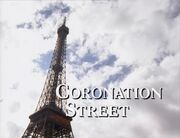
Paris-themed title sequence from Episode 4921
Several episodes have had unique title sequences, either due to special occasions or foreign location filming. With the first instance, in Episode 2631 on 18th June 1986, the titles show various images of Manchester at dawn, reflecting the fact that the opening scenes with the fire at the Rovers Return take place at 5.30am. Although the sequence was never used again, some images were recycled for the programme's end credits.
Three episodes in 2000 - 4917, 4919 and 4921 - were shot entirely on location in France and thus had special title sequences depicting the tourist spots of Paris, with different ones being used in each of the three instalments. The idea was revisited in Episode 6402 on 16th October 2006 when the programme returned to Paris, and again in Episode 7271 on 11th February 2010 with shots of Lake Windermere.
The programme also dispensed with the usual title sequence in its three live anniversary-related episodes - 4945 on 8th December 2000, 7487 on 9th December 2010, and 8740 on 23rd September 2015. In the first, transmitted on Coronation Street's 40th anniversary, the opening moment showing Sarah Platt telling David to come inside for his breakfast was transmitted in black and white with a "scratchy film" overlay to simulate supposed early broadcasts. As the picture mixed to colour, the music played and the Coronation Street title caption appeared. The other two examples feature the theme music played over montages of the current predicaments of the characters as of the beginning of the episodes.
Cat

An unknown cat wanders into shot
Today, the cat is seen as an essential ingredient in Coronation Street's opening title sequence, with four successive titles featuring one.
As explained above, the cat footage was left on the cutting room floor when editing the 1975 title sequence but was incorporated the following year at the insistence of producer Bill Podmore, who liked the shot. As regards the feline's identity, viewers who lived in Lower Broughton wrote letters to the Manchester Evening News in 1982 insisting that the cat was called Whiskey and belonged to a Mrs Norma Royle of 21 Duchess Street. A photograph taken by a local newspaper showing Norma and her family with Whiskey was displayed in Ascension School until it closed. However Eric Rosser, the programme's then archivist, stated in a letter published in the same newspaper on 5th April that this section of the sequence, directed by Ken Grieve and filmed by cameraman Ray Goode, was shot off Ashton Old Road in Manchester in 1975 near the location of a business called Arnold's Garage and the name of the animal who just wandered into shot was unknown.
The cat became so popular that when the time came to replace the sequence in 1990, a competition was held on ITV's This Morning programme to cast a cat to star in the new montage. The winner was Frisky, owned by Jon-Paul Rimington of Leeds who was paid a one-off fee of £200 for his services. From the mid-1990s to 2001, the shot that included Frisky was the last shot of the sequence. Frisky was asked to make a lot of charitable appearances which were handled by Kevin Horkin who ran an animal agency and had organised the competition. The cat finally died in 2000.
With the cat firmly established as an expected feature of the title sequence, one was included in the versions introduced in both 2002 and 2010, although it was far more prominent in the latter version than the one preceding it.
End credits
For most of its history, Coronation Street's end credits changed very little, consisting of scrolling credits displayed over an image of terraced rooftops, the street or the cobbles. Aside from the periodic changes enacted to match the style of the accompanying title sequence, the two biggest updates occurred in Episode 3216 on 22nd April 1991 when the credits were reduced in duration from sixty seconds to thirty, and Episode 4894 on 18th September 2000 when the programme abandoned a scrolling cast and production roll in favour of slides.
Cast and production credits
As of its first instalment, Coronation Street credited each episode's cast, writer, designer, director, and producer. Credits for Eric Spear (writer of the Coronation Street theme) and creator Tony Warren were added in episodes 5 and 13 respectively, in addition to the storyliners, script editor and executive producer (where appropriate) who were incorporated within the first few years. Particularly since the switch to slides in 2000, more of the production crew have been added, many on a rotary basis with different members of the team credited on different episodes.
The cast roll was initially presented in batches with names grouped together according to their characters' families or storylines. This practice was dropped with Episode 88 on 16th October 1961 in favour of appearance order. Except for a period between 6th August 1962 and 5th May 1965 when the programme featured a standardised cast list for the regular characters, order of appearance has remained the standard.

A typical episode ending in 1961, with "Next Episode" caption
In the first year, the action of each episode ended with a "Next Episode" caption. This was dropped after Episode 91, though exceptions were made afterwards to alert viewers when the programme was moved from its regular timeslot. Often in the 1960s, especially in the middle of the decade, overrunning episodes would leave out the cast credits, airing only production credits, or in extreme cases just the Granada endcap.
Once Coronation Street began regularly airing two episodes on one day in 2002, the credits format was changed with the second episode (or third, if three episodes were being aired) carrying a combined credits list for both episodes.
Tony Warren's credit
As a Granada staff writer, Coronation Street creator Tony Warren earned £30 a week regardless of how much he wrote and was not entitled to a creator credit in the programme. Starting with Episode 13 on 20th January 1961 - the first episode not to be written by Warren - the show carried the unusual credit of "From an original idea by Tony Warren". This was negotiated by Warren's agent in return for his client continuing to write for Granada, choosing the credit over royalties when bosses said he couldn't have both.
Other than those written by Warren, the credit appeared on every episode until some time in 1965, by which time Warren was no longer part of the writing team. The credit was restored with Episode 582 on 11th July 1966, now placed at the top of the production staff roll and phrased as "Based on an idea by Tony Warren". In Episode 7270, transmitted on 8th February 2010, the credit was amended to "Created by Tony Warren". A further change was made with Episode 8733 on 13th September 2015, with Warren's credit being brought forward to the very beginning of the end credits.
Images
In the programme's early years, the background stills displayed underneath the credits varied by episode, though some images were more common than others. Often shots from the title sequence would be re-used for this purpose, sometimes zoomed in, flipped horizontally or colour tinted. Other images which were unique to the end credits were shot and introduced at the same time as their respective title sequence.
Several episodes transmitted in the programme's first month presented the credits against a backdrop (in reality, a composite elongated photograph, the majority of which is Archie Street in Salford) which pans from the Corner Shop to the Glad Tidings Mission Hall, with the credits of the particular actors displayed when their character's house is on-screen. This was done to help viewers remember where the various characters lived. The last episode to do this was Episode 10 on 11th January 1961.
The graphic most often used from 1964 to 1969 was a still-image of the kerb and cobbles (pictured below). This was taken from a film sequence shot on location in Clifton Street in Ordsall showing the right-hand-side of "The Amalgamated Inn" and the houses beyond, though the full version was only used a few times after its introduction in Episode 366.
As with the 1969 title sequence, the end credits did not change into colour until two weeks after the main programme, switching over with Episode 928 on 17th November. The 1970s had the most variation in graphics, with a large number of episodes featuring scenes playing underneath the credits, such as Episode 1440 (pictured below, labelled "1974"). This was also common in the 1960s but became less so in the 1980s and afterwards. Other episodes featured a fade to black in place of an image.
In the latter half of the 1970s, an image looking down across the rooftops of a row of terraced houses from the 1975 title sequence became the standard graphic used, remaining so until 1991. The image became so ingrained that its replacements in the 1990s were also rooftop shots, including those first used in Episode 3243 and Episode 4706.
In 2000, the credits underwent a major overhaul, relegating the cast and production roll to a column on the right-hand-side to allow ITV to use the remaining space for advertising (a montage of images of the street or from the title sequence played underneath). This style was maintained when Coronation Street switched to widescreen with Episode 5191 on 7th January 2002.
With Episode 5370 on 28th October 2002, the end credits switched to a generic blue background as ITV standardised its programming. The next change, to columns of various shades of blue, took place in 2006. A more individual look debuted in Episode 6660 on 8th October 2007, in which the credits were displayed in a panel at the bottom of the screen underneath a montage of shots taken on the outdoor set. Their appearance has since reverted to a generic black background, beginning with Episode 8040 on 14th January 2013.
Advert breaks
As ITV is a commercial channel, every episode of Coronation Street has had an advert break. The break is preceded and followed by an 'End of Part One' and 'Part Two' photocaption respectively (although since 2002 the captions have simply read Coronation Street). For some episodes, particularly in the mid to late 1970s and parts of the 1980s, there was no photo caption at all, with the 'End of Part One' and the 'Part Two' words and music played over the respective scenes of the particular episode. This practice has begun to be used again for some episodes since the year 2000.
Until 2010, with some exceptions, the 'End of Part One' music has been a unique three bar tune, however the 'Part Two' music used has been the main opening title music, albeit faded out after three or four bars. Since 2010, both the 'End of Part One' and the 'Part Two' music have been a shortened arrangement of the main opening title music.
Notes
- Previously, in an episode containing the death of a significant character, the credits roll without the music. An example is the death of Alison Webster.

